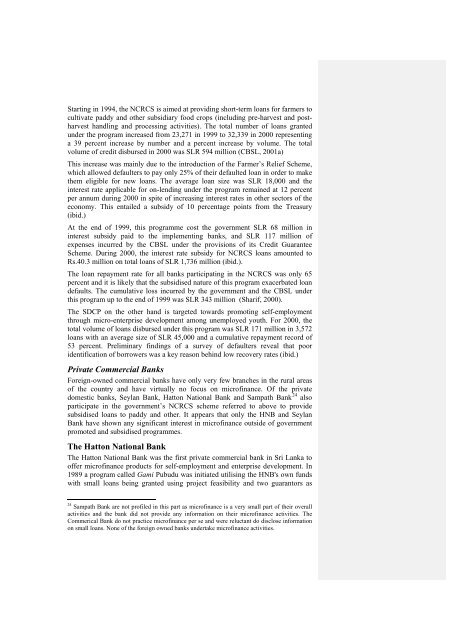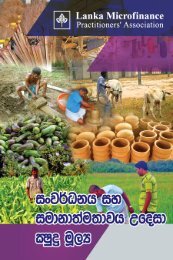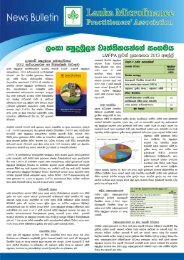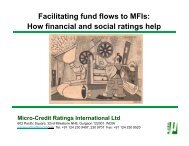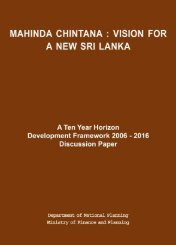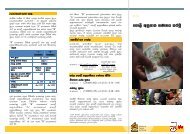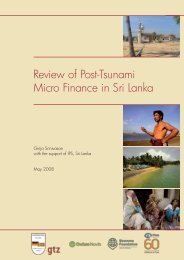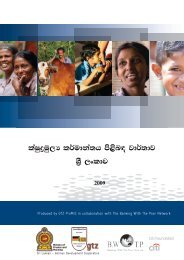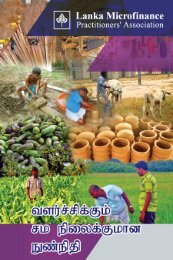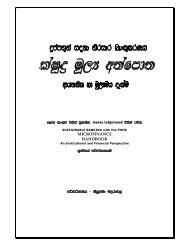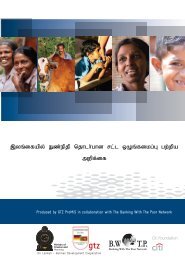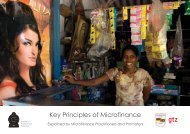National Microfinance Study of Sri Lanka: Survey of Practices and ...
National Microfinance Study of Sri Lanka: Survey of Practices and ...
National Microfinance Study of Sri Lanka: Survey of Practices and ...
You also want an ePaper? Increase the reach of your titles
YUMPU automatically turns print PDFs into web optimized ePapers that Google loves.
Starting in 1994, the NCRCS is aimed at providing short-term loans for farmers to<br />
cultivate paddy <strong>and</strong> other subsidiary food crops (including pre-harvest <strong>and</strong> postharvest<br />
h<strong>and</strong>ling <strong>and</strong> processing activities). The total number <strong>of</strong> loans granted<br />
under the program increased from 23,271 in 1999 to 32,339 in 2000 representing<br />
a 39 percent increase by number <strong>and</strong> a percent increase by volume. The total<br />
volume <strong>of</strong> credit disbursed in 2000 was SLR 594 million (CBSL, 2001a)<br />
This increase was mainly due to the introduction <strong>of</strong> the Farmer’s Relief Scheme,<br />
which allowed defaulters to pay only 25% <strong>of</strong> their defaulted loan in order to make<br />
them eligible for new loans. The average loan size was SLR 18,000 <strong>and</strong> the<br />
interest rate applicable for on-lending under the program remained at 12 percent<br />
per annum during 2000 in spite <strong>of</strong> increasing interest rates in other sectors <strong>of</strong> the<br />
economy. This entailed a subsidy <strong>of</strong> 10 percentage points from the Treasury<br />
(ibid.)<br />
At the end <strong>of</strong> 1999, this programme cost the government SLR 68 million in<br />
interest subsidy paid to the implementing banks, <strong>and</strong> SLR 117 million <strong>of</strong><br />
expenses incurred by the CBSL under the provisions <strong>of</strong> its Credit Guarantee<br />
Scheme. During 2000, the interest rate subsidy for NCRCS loans amounted to<br />
Rs.40.3 million on total loans <strong>of</strong> SLR 1,736 million (ibid.).<br />
The loan repayment rate for all banks participating in the NCRCS was only 65<br />
percent <strong>and</strong> it is likely that the subsidised nature <strong>of</strong> this program exacerbated loan<br />
defaults. The cumulative loss incurred by the government <strong>and</strong> the CBSL under<br />
this program up to the end <strong>of</strong> 1999 was SLR 343 million (Sharif, 2000).<br />
The SDCP on the other h<strong>and</strong> is targeted towards promoting self-employment<br />
through micro-enterprise development among unemployed youth. For 2000, the<br />
total volume <strong>of</strong> loans disbursed under this program was SLR 171 million in 3,572<br />
loans with an average size <strong>of</strong> SLR 45,000 <strong>and</strong> a cumulative repayment record <strong>of</strong><br />
53 percent. Preliminary findings <strong>of</strong> a survey <strong>of</strong> defaulters reveal that poor<br />
identification <strong>of</strong> borrowers was a key reason behind low recovery rates (ibid.)<br />
Private Commercial Banks<br />
Foreign-owned commercial banks have only very few branches in the rural areas<br />
<strong>of</strong> the country <strong>and</strong> have virtually no focus on micr<strong>of</strong>inance. Of the private<br />
domestic banks, Seylan Bank, Hatton <strong>National</strong> Bank <strong>and</strong> Sampath Bank 24 also<br />
participate in the government’s NCRCS scheme referred to above to provide<br />
subsidised loans to paddy <strong>and</strong> other. It appears that only the HNB <strong>and</strong> Seylan<br />
Bank have shown any significant interest in micr<strong>of</strong>inance outside <strong>of</strong> government<br />
promoted <strong>and</strong> subsidised programmes.<br />
The Hatton <strong>National</strong> Bank<br />
The Hatton <strong>National</strong> Bank was the first private commercial bank in <strong>Sri</strong> <strong>Lanka</strong> to<br />
<strong>of</strong>fer micr<strong>of</strong>inance products for self-employment <strong>and</strong> enterprise development. In<br />
1989 a program called Gami Pubudu was initiated utilising the HNB's own funds<br />
with small loans being granted using project feasibility <strong>and</strong> two guarantors as<br />
24 Sampath Bank are not pr<strong>of</strong>iled in this part as micr<strong>of</strong>inance is a very small part <strong>of</strong> their overall<br />
activities <strong>and</strong> the bank did not provide any information on their micr<strong>of</strong>inance activities. The<br />
Commerical Bank do not practice micr<strong>of</strong>inance per se <strong>and</strong> were reluctant do disclose information<br />
on small loans. None <strong>of</strong> the foreign owned banks undertake micr<strong>of</strong>inance activities.


